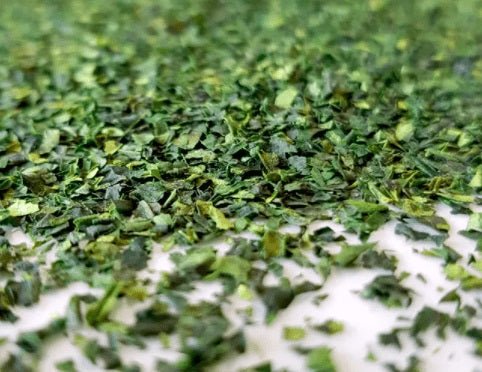
About Tencha: The Leaves That Become Matcha Powder
Share
Tencha is the specific type of tea that gets milled into matcha - without high quality tencha, you can’t have good matcha. But tencha isn’t just a name for any green tea. It is grown under certain conditions to make it ideal for matcha.
Tencha has its origins in Uji, a city just south of Kyoto and considered the epicenter of matcha. It was there that farmer’s first devised a reliable method to replicate the tea that had been praised in Japan up to that point. Namely, the tea coming from a few Buddhist monasteries, nestled in fog-shrouded mountains. Trying to replicate these conditions, the first tencha farmers settled on shading the tea leaves as the key to success. That is to say, shading mimicked the effect of fog on the growth of tea leaves.
So, why is shading important? There are a few reasons. First of all, it produces a sweeter, more savory and smooth tea. It is sunlight that converts savory amino acids, such as the relaxing L-Theanine, into catechins, which, although healthy, can come across as rather bitter. Block out the sunlight, and you stop this process of catechin conversion, and keep the tea savory and smooth. Another effect of shading comes via the adaptive mechanisms the tea leaves employ in an attempt to capture more light. One of these is an increase in chlorophyll, which makes the tencha - and the matcha it produces - a vivid green. Another is that the tea leaves grow wider, spreading out to try and catch what little light it can. As the leaves spread, they also become thinner. After picking, the tencha is not shaped or rolled in any way, leaving the leaves in their natural, extremely thin and, thereby brittle, state. This makes the leaves ideal for milling into an ultrafine powder. Additionally, because the cell walls within the leaves are not as broken down as with other green teas, if you try to brew loose-leaf tencha, the result will be a very light cup of tea - quite a far cry from the intense experience of matcha!
The shading method is applied at the very outset of the tea bush’s growth cycle each spring, such that the young leaves are almost never exposed to the full light of the sun. But beyond shading, there are many other considerations that go into producing high quality tencha. The effects of climate, soil, weather patterns, as so on but all be taken into account, and may inform cultivar selection and the farming methods. There are countless different cultivars, each with their own particularities, and a farmer must choose one well suited to their farm and market.
Additionally, because the primary product of the tea bush is vegetative growth, i.e. the leaves, and because higher nutrient content in the soil results in high amino acid content in the leaves, critical decisions must be made regarding fertilization. With excessive fertilization, tea bushes are more open to pests, requiring even further unnatural interventions via pesticides, all of which shortens the life of a tea bush. But, the resulting tea will be very savory and smooth, and consequently will conform to what consumers have come to expect of high quality matcha.

This is why we like highlighting single cultivars with unique flavors at our tea house. Matcha can be much, much more than an umami-bomb, displaying a vast array of floral notes like lilac, wildflowers, and sakura, or fruit notes like passion fruit and pineapple (all notes we’ve tasted in our matchas in the past)! Savoriness is good as well, but ultimately the subtlety of high quality tencha and the art of tencha farming can’t be appreciated in full if it is pursued to the exclusion of other qualities. So the best tencha farmers carefully consider the most sustainable, natural ways to fertilize their fields, balancing the degree of their own intervention with the natural expression of the tea bush itself. With different climatic conditions each year, along with generally warmer temperatures, earlier springs, and more competition than ever before, tencha growing looks more and more like an art form each year.
This is why, at Northeast Tea House, we place a strong emphasis on sourcing the best tencha possible. Combined with the fact that we mill it fresh in-house, the result is outstanding, and with some tenchas even approximates the type of matcha one would find in pre-industrial Japan. In our next blog post, we’ll take an even closer look at the specific tenchas we use via a comparison of our various cultivars.
Thanks for reading!
Simon
Head Tea Guy and Matcha Miller
